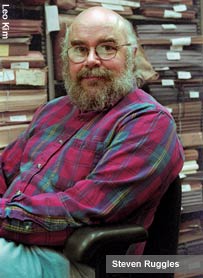

|
| ||||
 |
 | |||
Historian Steven Ruggles: Tracking terabytes
"Social history is pretty slippery stuff," says Steven Ruggles. A longtime practitioner in the field, Ruggles should know. Over the years he has seen experts use quotes, data, and other evidence to argue that a trend was on the rise during a particular period--while others used the same quotes, data, and evidence to argue that the very same trend was in fact waning. "It's hard to figure out what the direction of trends is," he says. That's why Ruggles, a U of M history professor for 18 years, likes to stick to hard data: census numbers. In the past few decades, the McKnight Distinguished Professor has helped make the U a leader in population studies, building on his department's strengths in quantitative history. In 2000, he helped launched the Minnesota Population Center, which fosters connections among population researchers across disciplines and provides historical census data as well as other research materials online. The center, housed in a building on the West Bank, gathers and organizes population data from around the globe. Ruggles, the center's director, has managed to attract more than $5 million in grants to his enterprise. "I really like data," Ruggles says. "Most of my energy goes into data infrastructure projects, where we collect and make available domestic and international census data. That's turned into a pretty big operation." Big, indeed. The center employs roughly 100 people, thanks to the grants, and its public databases now hold "roughly a terabyte" of data, Ruggles says. More than 7,500 journalists, scholars, and educators have registered to use the public databases for research and public policy work on issues ranging from family systems to health care delivery to global economic development. For a quantitative historian, the ability to compare, say, mortality and fertility data from different decades or different countries is priceless. "The advantage of it is that you can actually be reasonably confident about your conclusions about the social changes that you're looking at," Ruggles says. He himself has used quantitative census data to examine changes in the American family. Most recently, he has examined the impact of economic opportunity: As people began working for wages, they became less tied to old family structures, Ruggles posits. No longer dependent on their elders for land and inheritance, young laborers upended the traditional social hierarchy, making it, in essence, more democratic. That argument is part of a book that Ruggles is working on. Culling and organizing the data that lead to such conclusions is no easy task. A branch of the National Institutes of Health recently awarded the Minnesota Population Center two grants for making samples of the 1880 and 1930 census publicly available via the Internet. Ruggles's collaborators, working with old census data, must first transfer the data from microfiche film to computer. Even new data in electronic form, from the United States and Europe, must be organized so that accurate comparisons can be made. Historians long have used samples of U.S. census data to draw conclusions, but Ruggles was surprised when he tried to compare U.S. figures with other international data. How, he wondered, has the North American Free Trade Agreement affected the economies and labor markets of Canada, Mexico and the United States? Ruggles wanted to look at the issue in terms of such information as nature and location of occupation. But no common database existed, he found. Now, with a $3.5 million grant from the National Science Foundation, Ruggles and his operation are developing an international database of uniformly coded historical censuses from as many as 20 countries. In 2001, the NSF also awarded Ruggles a half-million dollars for the North Atlantic Population Project, which will pull together machine-readable data from Iceland, Norway, the United Kingdom, and the United States. But while Ruggles is ecstatic about the success of his projects thus far, he's also keenly aware that funders could turn off the tap at any time. The duration of the projects he's working on, he says, could easily outlast his lifetime, so it's vital to work as quickly as possible on key areas of population data. "There's so much to do. It's a matter of deciding what the most critical areas are, because this could end at any time," Ruggles says. "The funding agencies could decide, well, enough is enough. We have good data now. But there's much more [to be done] than we could ever do." |